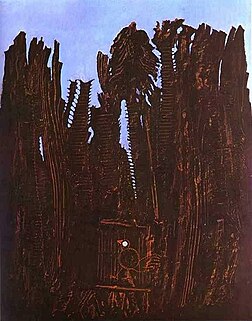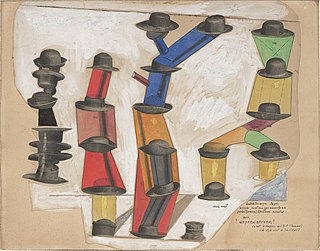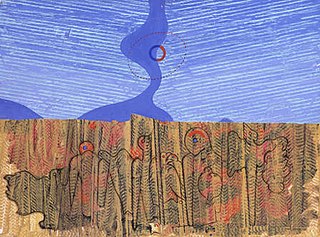 W
WAquis Submersus is a painting by the German dadaist and surrealist Max Ernst created in 1919. Influenced by the Italian metaphysical art it is one of Ernst's earliest works showing surrealistic accents. It currently resides at the Städel Museum in Frankfurt, Germany.
 W
WThe Barbarians is a 1937 painting by German surrealist painter Max Ernst.
 W
WThe Elephant Celebes is a 1921 painting by the German Dadaist and surrealist Max Ernst. It is among the most famous of Ernst's early surrealist works and "undoubtedly the first masterpiece of Surrealist painting in the de Chirico tradition." It combines the vivid dreamlike atmosphere of Surrealism with the collage aspects of Dada.
 W
WThe Eye of Silence, 1943–44, is a painting by German dadaist and surrealist Max Ernst.
 W
WForest and Dove (1927) is a painting by the German surrealist Max Ernst. It depicts a nocturnal scene of a forest of bizarre, abstract trees. In the thick of the forest is a childlike depiction of a dove.
 W
WThe Hat Makes the Man (1920) is a collage by the German dadaist/surrealist Max Ernst. It is composed of cut out images of hats from catalogues linked by gouache and pencil outlines to create abstract anthropomorphic figures. There are inscriptions in ink that read "seed-covered stacked-up man seedless waterformer ('edelformer') well fitting nervous system also tightly fitting nerves! ." The idea for this work began as a sculpture made from wooden hat molds.
 W
WLittle Machine Constructed by Minimax Dadamax in Person (1919–20) is a mixed-media work of art by the German dadaist and surrealist Max Ernst.
 W
WMurdering Airplane (1920) is a collage by the German dadaist Max Ernst. It depicts a monstrous aircraft with human arms flying over an open field. In the lower right-hand corner two soldiers are carrying a third wounded soldier.
 W
WNapoleon in the Wilderness is a 1941 surrealist painting by Max Ernst in the collection of the Museum of Modern Art in New York City.
 W
WPietà or Revolution by Night (1923) is a painting by German surrealist and Dadaist Max Ernst. Since 1981 it has been part of the collection of the Tate Gallery in London.
 W
WThe Temptation of Saint Anthony is a 1945 painting by the German artist Max Ernst. It depicts the desert father Anthony the Great as he is tormented by demons in Egypt.
 W
WTrophy, Hypertrophied (1919) is a work of art by the German dadaist/surrealist Max Ernst. This is one of Ernst's earliest known works. It was created through a photomechanical process called line-block printing, rarely used in printmaking, to which drawing was added. It depicts a complex mechanical apparatus with celestial shapes as gears. Ernst created a similar piece the same year titled Farewell My Beautiful Land of Mary Laurencen. Help! Help!
 W
WThe Wood (1927) is a painting by the German surrealist Max Ernst.